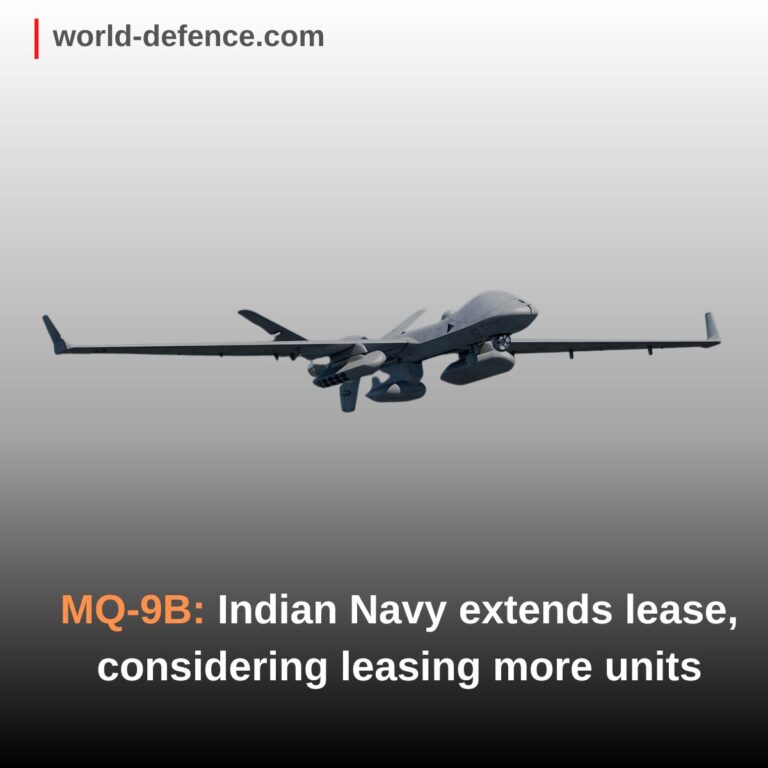
The Indian Navy has extended the lease of two Sea Guardian drones from a major American defence contractor for an additional two years in order to increase surveillance over the Indian Ocean Region (IOR) after the MQ-9B clocked an impressive 10,000th flight hour and covered 14 million square miles of operating area in the previous two years.
General Atomics leases the MQ-9Bs to the Indian Navy under a Company-Owned, Company-Operated (COCO) arrangement. Indian Navy is also leading negotiations for the procurement of 30 armed MQ-9B drones for more than $3 billion, with the air force, army, and army each receiving 10 drones.
Deal is now stalled owing to cost, weapons package, and technology sharing concerns. According to media sources, the Indian Navy may lease two additional MQ-9B from General Atomics until the agreement is finalised.
According to a recent study, the Army and Air Force are less enthusiastic about the purchase because to high procurement expenses, however the Navy is quite enthusiastic about its procurement.
What are the MQ-9B Predator drones

The death of Al-Qaeda leader Ayman al-Zawahiri at the hands of Hellfire missiles fired from MQ-9 Predators (also known as Reapers) made this US aircraft the centre of military attention once again.
India is reportedly in advanced stages of negotiations to acquire 30 MQ-9B Predators, so let’s find out more about these Predator drones.
History of Predator MQ-9B drones

After the failure of GNAT 750 operations over Bosnia and Herzegovina in 1993 and 1994, Predator drones were created in the early 1990s for aerial reconnaissance and forward observation tasks.
GNAT 750 suffered from a number of technical faults, and RQ-1 Predator replaced it as a more capable and improved medium-altitude tactical reconnaissance aircraft.
In 1995, it was also operating over Bosnia and Herzegovina, and it later saw battle in the US wars in Afghanistan, Iraq, Pakistan, the 2011 Libyan civil war, and the 2014 Syrian intervention.
The United States Air Force (USAF) sensed the need for more advanced versions by 1999, therefore General Atomics began work on the Predator B, which entered service as the MQ-9 Reaper in 2007 as the successor to the original Predator.
Predator is operated by the CIA and the USAF, which classifies it as a “Tier II MALE UAS” (medium-altitude, long-endurance unmanned aircraft system).
MQ-9B: Technical specification

Two variations of the MQ-9B exist: SkyGuardian and its sister SeaGuardian. Since 2020, the Indian Navy has utilised the MQ-9B Sea Guardian.
According to General Atomics, the MQ-9B Sea Guardian can carry up to 12,500 pounds (5,670 kg) and has a 6,000-pound fuel capacity (2,721 kg).
The drone can operate at altitudes greater than 12,000 metres, providing the Indian military with surveillance capabilities in the Himalayan border regions located at high altitudes. The maximum endurance of the Predator is 40 hours, making it excellent for long-term monitoring.
In addition, the MQ-9B Sea Guardian may provide land, maritime, anti-submarine, anti-surface, strike, electronic warfare, and expeditionary duties.
Additionally, the MQ-9B Sea Guardian is capable of autonomous takeoffs and landings.
The USAF refers to the MQ-9 and other UAVs as remotely piloted vehicles/aircraft (RPV/RPA). The aircraft is monitored and controlled by aircrew in the Ground Control Station (GCS) and is commonly known as the first hunter-killer UAV in the United States.
Why is India in need of MQ-9B Predators?
India requires the armed drones, at a cost of more than $3 billion, to bolster its surveillance apparatus along its border with China and in the Indian Ocean region.
Since 2020, India and China have been engaged in military standoffs at various sites along their 3,488-kilometer-long frontier, with reports indicating that each side has deployed up to two lakh troops.
India has significantly increased surveillance along the Line of Actual Control (LAC) by deploying a fleet of unmanned drones; the inclusion of these drones would be a significant improvement to India’s monitoring programme.
China’s increasing naval activity in the Indian Ocean Region (IOR), including the docking of its latest-generation space-tracking ship — the Yuan Wang 5 — capable of monitoring satellites, rockets, and intercontinental ballistic missile launches close to the Indian coastline, makes the need for Reaper drones imperative for controlling China.
In addition, other publications emphasised that the Indian Navy is pleased with the performance of the Predators. In 2020, the navy accepted two MQ-9B Sea Guardians. General Atomics provided the drones on a one-year lease, which was extended due to their performance.
Some crucial missions performed by MQ-9B Predator/Reaper drones
In January 2020, the MQ-9 Reaper reportedly killed Iranian General Qasem Soleimani outside the Baghdad airport. Soleimani was the leader of Iran’s special Quds Force and the top commander of the Islamic Revolutionary Guard Corps. He was in charge of Middle Eastern operations.
The murder escalated US-Iran relations to a new level, prompting Iran to launch multiple missiles at US positions in Iraq. On the American side, however, neither damage nor injuries were reported.